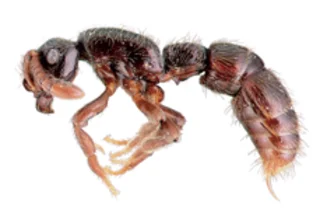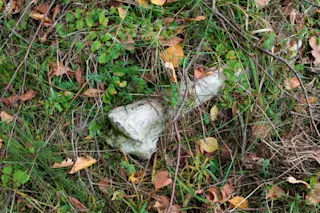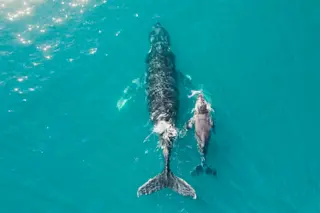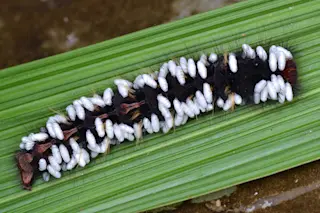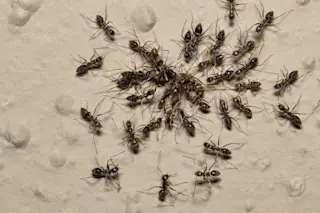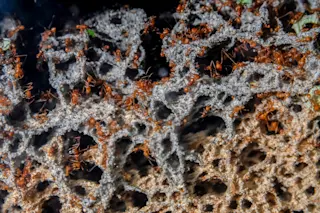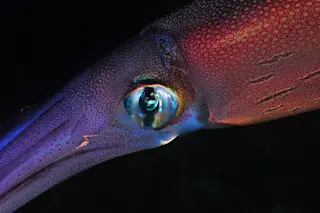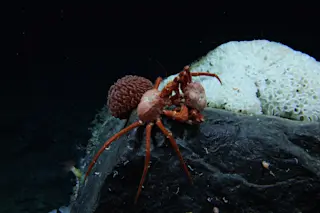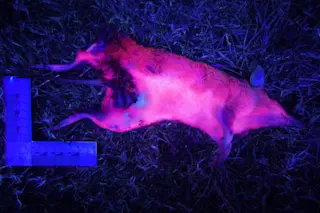In the bleak hour before dawn in southeastern Madagascar, biologist Brian Fisher and a team of five field assistants stand outside a grand, but at this moment lifeless, French colonial railroad station. The passenger train will not be running today, due to some quirk of developing-world travel. When the first railroad workers arrive, Fisher consults with them in French and Malagasy, pointing to a roadless site on a topographic map. A few hours later, suitable friendships having been formed, a freight train squeals to a stop at a rendezvous outside of town, a plume of steam drifting back from the locomotive. Fisher and his crew pile tents, machetes, headlamps, mesh sacks, pan traps, cookware, and a basket of live chickens into an empty boxcar, which carries them thumpeta-thumpeta out into the hills. Or rather, THUMPeta-THUMP-eta. These battered old boxcars have no springs. Hanging out the open door, Fisher cannot help grinning, jumping a freight train being a forgotten childhood fantasy. For anybody else, this would qualify as an adventure.
And for Fisher? Among other hazards of tropical biology, he has endured a leech up his nose and nematodes "moving fast" under his skin. He has suffered leishmaniasis—and treatment for it with the heavy metal antimony. Once, in Gabon, he collapsed with malaria. A Bakwele Pygmy woman saved his life by carrying him 18 miles on her back to get an injection. He has posed as a Frenchman among Muslim money changers who had just learned about the U.S. invasion of Iraq. And he has been caught in the middle of a war in the Central African Republic. To escape the fighting, he had to cross a river between countries. Border guards picked him up, but he got away from them and joined up with a missionary pilot. Then he persuaded Air France to let him board a flight to Paris without travel documents or a ticket. As he negotiated this feat, he was dressed in blood-smeared clothes and was using a snake stick as a cane because one unshod foot was grossly swollen with elephantiasis. In his other hand he carried a greasy paper bag of barbecued goat meat just purchased from a street vendor because he was starving.
"I'm glad all my work is in Madagascar now," he says mildly, "because the African work was slowly killing me."
Most people would not risk death and misery even for a fortune. Fisher does it for ants. A slight, bearded 41-year-old researcher at the California Academy of Sciences, he has an unstoppable, infectious enthusiasm for ant biology and behavior. He is convinced that if people knew what they were looking at—if they had access to basic information about the ants living in their backyards, not to mention those at the opposite ends of the Earth—they would be as gung ho about them as he is.

Proceratium google hunts only spiders' eggs. "Like Google, the ant is really good at finding obscure prey," says biologist Brian Fisher, who admits he had ulterior motives for naming the species after the search engine. In addition to cataloging all known ant species on his site, www.antweb.org, he dreams of one day persuading Google to partner with the scientific community and create an Internet database of all life on Earth. | Courtesy California Academy of Sciences, April Nobile, Antweb.org
To help make that happen, Fisher has created a Web site aimed at doing for ants what bird-watching guides have done for birds. So far, AntWeb (antweb.org) concentrates on two regions, the United States and Madagascar. But Fisher's ambition is to take Madagascar's ant fauna from the least known to the best known in the world over the next decade. Then he'll use his approach as a model for conquering the planet, with all of the estimated 22,000 ant species on Earth identified and online. Given that only about 12,000 of them have been described since Linnaeus named his first ant in 1758, this is no small goal.
To achieve it, Fisher has become a leader of the movement to change the way scientists collect and describe new species, mainly with the help of computer technology and DNA sequencing. He's known for using any tool it takes to get a job done faster, cheaper, and more efficiently. Once, for example, he went to Costa Rica with a vacuum cleaner, sucked up 500,000 army ants, and brought them home alive to the academy, where he released them in a vast, looping floor-level display case that wound through the exhibition area. Kids could position themselves and watch the ants come thundering down on their prey.
E. O. Wilson, the godfather of ant biology and the conservation movement, calls Fisher's methods "industrial-strength taxonomy." He means it as high praise. Fisher himself says he aspires to the time-and-efficiency thinking of a car manufacturer.
One morning, Fisher kneels on a hillside in the rain, eyes glinting, machete embedded in the soil beside him. His headlamp lights up a patch of tiny white blobs on the base of a tree. The blobs are insects called coccids, which sip sugar from the tree and excrete a droplet of honeydew. Camponotus ants harvest the honeydew for food and tend the coccids like sheep.
"Ants invented herding," says Fisher. "If something were to come in and try to eat the coccids, the ants would pick them up and carry them below to protect them." Camponotus queens flying off to found a colony sometimes carry coccids with them to help set up housekeeping.
The conversation jumps to the genus Melissotarsus, which drills a hole in a latex-producing tree and lives in a silk-lined tunnel inside. "It's the only ant genus where the adults produce silk. The whole gigantic head is a big silk gland. The front legs have been modified into silk brushes, to pull out silk and stretch it to where it's needed. The funniest thing about this ant is that its middle legs go up instead of down because it lives in tunnels.
It's the sort of weird behavior that makes Fisher love ants, and especially the ants in Madagascar, where he has collected more than 800 new species. Madagascar is an island of extreme diversity. "There's a place in the south," he says, "where you can stand with one foot in the rain forest being sucked on by land leeches and the other foot in a spiny thicket with baobab trees and a 12-month dry season."
Located 250 miles off the southeast coast of Africa in the Indian Ocean, Madagascar is also surprisingly large, about the size of France. Fisher decided to focus his field research efforts there in 1992. To make sense of the place in a systematic way, he overlaid geologic maps with bioclimatic maps and listed 130 sites where the combined features promised to harbor interesting ants.
Says E. O. Wilson: "It's not the old style, which I admit I followed most of my life, of going where you can get. Brian laid out a series of sites that he felt were necessary for a complete sampling, and he just got there. That's an improvement."
Fisher and his crew generally travel from site to site in a Toyota Land Cruiser, staying in the field for two months straight in the thick of the rainy season, the best time for ants and the worst time for roads. At one point, when the vehicle got bogged down in an area with no trees for attaching a winch cable, Fisher and his team hiked six miles, cut down some trees, carried them back, dug holes, planted the trees, winched the vehicle 30 feet forward, then dug up the trees, replanted them—and did it again and again for two days.
Among other techniques for crossing flooded rivers, he sometimes attaches ropes to the sides of the Toyota and positions swimmers in midstream. Then he drives in till the water laps the windshield. (Any deeper, Fisher says, risks a rollover.) He shuts down just before the engine floods and waits while the swimmers haul the ropes to the opposite bank and tow. It doesn't always work.
One time, the engine died at night in the middle of a fast-moving river. The water rose. Fisher walked to the nearest village and woke up the headman, who organized a caravan of oxcarts hauled by zebus, the local cattle. The party arrived back at the river at dawn, and the headman stood on the hood of the car crying out orders to the five zebu teams spread out ahead. The car started to move. But the opening in the riverbank was too steep and narrow for the zebus. So Fisher walked 15 miles to a shrimp farm, then bushwhacked back ahead of a borrowed tractor.
"You read these stories about cowboys going all night, and I'm thinking, 'How do they do that?' But you can, when the time comes. We didn't eat for two days, and you can do that too."
Doing it for ants does not strike Fisher as odd. He grew up in Normal, Illinois, the son of a science education professor and a grade-school teacher, both tolerant of his youthful interest in animals (though his mother screamed when a pet alligator joined her in the shower). He came to science intent on discovering new things. As a graduate student, he studied the ways ants and plants benefit one another. But on a research trip up the highest mountain in Panama, it dawned on him that all the plants were already named. "I said, 'What about these ants?' And nobody knew the species, or even the genus." So he spent a year getting retooled in insect systematics. Then, for his Ph.D. thesis, Fisher set out to retool the science he had just learned, testing and revamping techniques at every stage of the taxonomic game.
"These are the magic devices," Fisher announces one morning, as he hangs up lanternlike cloth bags on a clothesline under a tarp. "This is why we are able to go to a place and collect all these things that none of the other collectors saw." A beetle researcher originally developed the device, called a Winkler bag, but Fisher refined it and established the protocol for making it a standard tool for biological inventories.
Here is the protocol: Get down on your knees, machete in hand, and start hacking at the patch of earth directly in front of you. Shovel the resulting hash into an upside-down witch's hat, with a sieve near the brim. Then bounce up and down repeatedly. The soil, which sifts through the sieve to the point of the witch's hat, doesn't look like much. "You'd never guess that in that brown mess, there are all these beautiful brown insects," says Fisher. "And when you're doing it, you're thinking, 'There's nothing here.' "
The soil then gets carefully measured into mesh sacks and hung up inside a Winkler bag. The Winkler exploits the tendency of soil dwellers to escape by heading down, enticing them into a plastic bag filled with alcohol. Next day, the alcohol has become a tea-colored soup studded with worms, shrimp-like amphipods, and drifting ants, their delicate legs akimbo.
At the same time, yellow pan traps and malaise traps are doing their dark work. The pan traps are disposable plastic cereal bowls filled with soapy water. Ants and other creatures cannot seem to resist climbing in for a swim. Malaise traps are tentlike mesh devices set up along natural flight paths. Flying insects escape danger by moving up, not down. So when insects land on the mesh, the angled ridge of the trap leads them up and over the edge into a jar of alcohol at the top. More soup.
"I like traps that work while we sleep," Fisher says.
Shortly after dawn, he and his crew fan out across a ridge. Like any cost-driven entrepreneur, he has opted to send much of the basic work of taxonomy offshore, where he can train and pay five technicians for the cost of a single one in the United States. "You have to move to where the labor market can support the labor," he says. "And it's also where the biodiversity is, and where you want people to learn about it and appreciate it."
His team, including a former taxi driver, a cook, and a mosquito biologist, have become zealous ant hunters. (Some past crew members have gone on to earn advanced degrees in entomology.) The forest soon resonates with the splintering of rotten logs and the snapping of branches. One worker wraps his fingers under a mat of grass and peels it back, the muted popping of the roots like a string of firecrackers going off in the distance. Then comes the soft pttt-pttt of a "pooter," a pencil-thick rubber hose held between the lips and used to suck up ants. It has a fine mesh screen to divert specimens away from the mouth and into a collecting tube. Off in the distance, someone is flailing away at the underbrush with a stick, collecting everything that falls out on a white square of cloth stretched over a PVC frame and then—pttt-pttt—sucking up the interesting stuff.
The workers stop chasing ants only for their ritual food break every three hours. Even then, they hold up tiny vials to a high window of light in the forest canopy and recite treasures for Fisher to scribble down in his "Rite in the Rain" notebook: "Tetraponera, low vegetation. Anochetus, under log. Pheidole, ex rotten log." When they have finished with this patch of forest, it looks like the aftermath of a vigorous police search, everything upside down and inside out. It will take the ants a week or two to put it right again.
His solution is to democratize the science of biological classification. AntWeb makes detailed photographs of museum specimens available at the click of a mouse. It also provides links to the scientific literature for each species at an American Museum of Natural History Web site, antbase.org. Thus the Internet provides anyone anywhere with the tools to discover new species. In "team taxonomy," Fisher says, backyard naturalists will be able to recognize what's unusual in their own neighborhoods and then collaborate with professionals to enter it into the annals of science.
The problem with traditional methods of collecting and preserving specimens isn't just that they're slow, Fisher says, but that they often make the results inaccessible to almost everyone. Everything comes down to the specimen on its pin, a sort of sacred totem to the taxonomic priesthood. The shaft of the pin holds tiny, folded scraps of paper full of spidery notations of crucial data like the time and place of collection. If the collector was especially enthusiastic or if the species has been renamed in the course of a taxonomic revision, a pin may hold up to 10 different labels. To read the bits of paper, you have to slide them off the pin with a pair of tweezers.
That is, assuming you can find the right pin. The rules dictate that there should be a "type specimen" establishing the characteristics of the species for all time. But as he traveled through the world's great natural history museums trying to assemble the basic data about Madagascar species, Fisher found that past collectors often failed to label specimens as "types." They also neglected to name the museums where they were stored.
Idiosyncratic organizing schemes further complicated Fisher's search. Specimen pins are typically stored standing upright in neat rows inside glass-topped boxes. One national museum boasted more than 300 boxes of ants. "But if you wanted to find collections for Madagascar," says Fisher, "you had to start at box one and study every box." He also had to use his field headlamp to see the ants in the dim museum light.
"It was abysmal," he says. "It was sad. The myth is that this is forever. You create the specimens, and that's your legacy forever. You think it will be looked after by society." He pauses. "They've been forgotten. They're shoved in a corner nobody's looked at for 100 years. They're in such disarray!"
The emphasis, says Fisher, shouldn't be on the specimen as the sole bearer of all information—it should be on the Web site or the database, with the specimen serving only as a voucher. "It's such a subtle change, but it really frees you up," he says. The Web site gives a collector the space to record detailed ecological data about a specimen. Other people can find the information almost instantly and organize it any way they want—by "Madagascar type specimens," for instance, or by "ants worldwide" found "ex rotten log."
Web sites can also include genetic information. Proponents of DNA bar coding analyze a short piece of the genome—about 600 nucleotide base pairs out of the millions or billions in an organism—to see whether, say, two very different-looking individuals might in fact be the same species. To make that determination by traditional means, you need a taxonomist like Fisher with years of postgraduate training. In the case of ants, he must collect about 20 specimens, sit down at a microscope, and make 15 measurements on each one, where differences of a millimeter are crucial. But for $5, anyone can get a sequencing machine to look at a single mitochondrial gene and say, "This might be a new species." On his last collecting trip, Fisher shipped off the genetic raw material and in three weeks got back all the DNA sequencing data.
"It told you immediately what site was most diverse and what site was most unique," he says. "Taxonomists would shoot me if I said, 'Genes could replace taxonomy,' but for a lot of species, genes are the only data we're going to have. We have buckets of flies and wasps that nobody's working on. If we sequence them all, we'd at least have an idea what's out there. People say, 'That's not taxonomy.' Well, it's a type of taxonomy. It allows you to do all sorts of stuff about endemism, suggest new species, how different and how similar things are, without ever knowing the names of species.
"What they're afraid of is taxonomy being done poorly. What I want to show is that new tools will allow more people to participate in taxonomy, and we can do better taxonomy." Instead of being buried under a hundred lifetimes of unsorted specimens, taxonomists will be free to cut straight to difficult questions where their expertise can make a difference. It isn't the end of taxonomy, says Fisher. It's the golden age.
Fisher and his group move to a new site called Vatovavy, a fragment of forest in a saddle of land between two peaks. It has escaped deforestation because it is sacred to the dead, who are entombed in a building at the edge of the woods. Fisher is soon on his knees in front of a log crawling with Cerapachys ants.
"They're so beautiful to watch. They don't have a trail pheromone, so they walk head to butt, head to butt. They're like little beads on a necklace walking around, little shiny black pearls." Cerapachys is a relict genus, dating back more than 100 million years to when Madagascar split away from the mainland. Like a lot of the island fauna, says Fisher, it opens a window on early evolution. Elsewhere, Cerapachys-like ants evolved into army ants, probably more than 90 million years ago, before Africa and South America separated.
But here, the ancestral lineage still thrives. "They feed off the larvae and pupae of other ants. They trek out of the nest and into another ant nest and steal their larvae and take 'em home and eat 'em. You can tell they're primitive the way they walk around. They can't even scurry. They hadn't invented scurrying yet."
To Fisher, every ant, like Cerapachys, tells a story, and the stories only make sense if taxonomy can explain where a species fits into the scheme of evolution. Understanding the story isn't just a question of aesthetic or intellectual interest.
"Imagine the storehouse of evolutionary information," he says, "in 10,000 species living in the dark, wet soil, having to keep fungus and bacteria off their young and off themselves. Ants are chemical factories. They produce antifungal and antibacterial agents. So you think, My God, bioprospectors would love to get into this." Ants could become a precious pharmaceutical resource, especially now that resistance has rendered many conventional antibiotics ineffective.
Fisher argues that ants are also valuable in determining which habitats to preserve and which to let go. "Bird people and mammal people will go into a place and say, 'There's nothing here, it's all been hunted out.' And we'll go and say, 'There's the most interesting stuff. You've got to save it.' " Ants can't readily cross rivers, mountains, and other barriers. So they stay put and become specialists in a relatively small home range. This makes them a useful tool for detecting ecological subtleties that might not be evident just from looking at larger animals. To Fisher, a varied ant population suggests that "the forest has a unique history, a unique assemblage, and should be preserved even though it doesn't have some fuzzy vertebrate living there."
He balks at the idea of ants as a mere indicator species: "They're not just a shortcut to finding diversity; they are the diversity." It is not unusual, for instance, when one member of the team shows up during a snack break at Vatovavy with 10 genera of ants after just a few hours of collecting. "You can remove all the birds and still have a forest," says Fisher. "But you can't have a forest without invertebrates. It won't function anymore. The ants are the glue that holds it together."
He concedes that no one is likely to save a forest just for ants. But Madagascar president Marc Ravalomanana, a former businessman, has publicly committed himself to tripling the area of protected habitat on the island. Fisher is one of a group of scientists, conservationists, and government officials helping to determine which habitats merit protection. Other members of the group say his ant data are so thorough that, as they formulate their recommendations, they are using his facts in ways "almost comparable to the bird and mammal data."
On the drive back from Vatovavy, Fisher makes a flying stop at a conservation meeting in a national park. He bumps into Bernard Koto, the regional governor, a formidable figure with a background in conservation who is feeling pressure to come up with more acreage to be protected, and fast. (President Ravalomanana's deadline for tripling protected acreage is 2008.) Koto wants to know what Fisher has been finding at Vatovavy and whether the forest has the potential to become a reserve. It does not seem to trouble him that the biodiversity they are talking about is in the form of ants. Fisher promises Koto that he can have the Vatovavy data not in two years but in two months. Meanwhile, his crew members are quietly folding themselves back into their vehicle.
"This," says Fisher, his foot on the accelerator, "is how conservation gets done."


